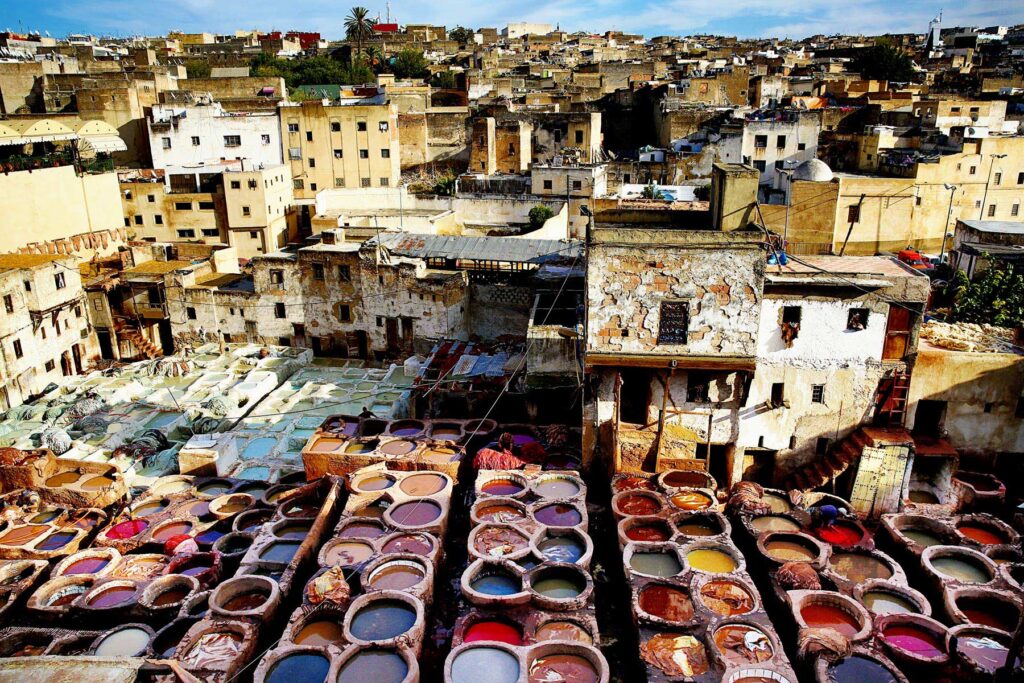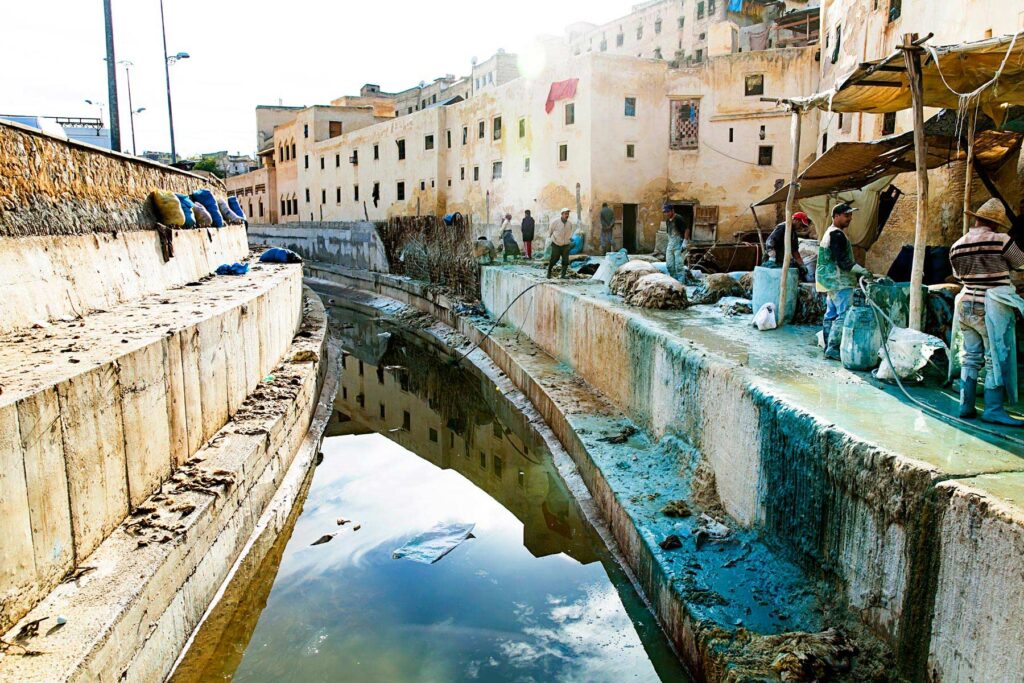TRAVEL CRITERIA
DURATION:
HALF AN HOUR
ACTIVE:



CULTURAL:




RECOMMENDED::
YES
PHOTOGRAPHY:




COST:


The view from the terrace at the Chouara Tannery across the pits below and the rooftops of the Fez medina.
Intro: When I learned about the famed tanneries of Fez, I was excited to not only photograph them from the viewing terrace above, but maybe get some VIP access for up close encounters with the pits and workers below.
Animal hides hung to dry in the open air after being dyed in the wells at the Chouara Tannery.
I’ll never forget the first time I heard about the tanneries in Fez. It was one evening a few weeks before heading to Morocco and I was asking Charlene what there was to do in each city we were visiting. When it came to Fez, besides touring the medina and possibly a few mosques, I wasn’t sure what else we were really going to experience.
After searching online for “Things to do in Fez”, I came across a photo of wells filled with various colors, below which was written: “Fez tanneries”. Wow! It was so colorful, like nothing I’d ever seen in my life before. After doing a bit more research, I found out that the tanneries were where workers turn dried animal skin into leather for various items, such as bags, jackets, and shoes. I also found out that it was one of the most popular places to visit in Fez, located right in the middle of the medina.
The only problem was that every single photo I came across online was either a wide or close-up shot of the tanneries from above. As beautiful as that viewpoint was, I wanted to see if there was a way to actually go down to the wells and get a much better perspective. It would’ve been disappointing to go all the way to Fez and not get an up-close and personal experience in the tanneries. Nevertheless, I was very much looking forward to visiting this place and hoping I could get some VIP-type access.
After arriving in the old capital of Morocco, Charlene and I did a guided tour of Fez with a local tour guide Ahmed. Earlier in the day, we visited the oldest university in the world, saw various occupations and industries in the medina, and even bought a Fez carpet. But after lunch, it was time to finally visit the tanneries!
In case you missed the first sign, there are plenty of other indicators to help you find the Chouara Tannery in Fez’s ancient medina.
We followed Ahmed’s lead as he guided us through the maze-like alleyways of the medina and came across a passage with a sign that read: “Tannerie Chouara”. Even without the sign, we knew we were close to the tanneries thanks to the strong smell in the air. The scent of dyed leather was one we will never forget (but wished we could avoid at all cost).
I just had to breathe in and out through my mouth and focus more on the aesthetics of experiencing this place than the odor. To be honest, it didn’t turn out to be as terrible as I had initially thought inside. Maybe it was my bad nasal congestion, or simply the fact that I was super giddy to be inside and excited to be taking images of the tanneries.
Looking out across the ancient medina of Fez which sprawls around the Chouara Tannery.
After going through the myriad of leather item stores, we finally made it to the balcony that oversaw the tanneries – and what a magnificent sight it was! I’m sure to the local folks, especially the ones working hard down below, it was just another day at the office, but for travelers and especially photographers like myself, this was like being at Disneyland and being able to go on every ride.
I tuned out pretty much everyone around me, including Ahmed and the gentleman trying to sell me leather goods. I kindly told him I wasn’t interested in buying anything and just wanted to take photos of the place. At that point, the only thing I wanted more was to be able to go down to the floor level and walk around the wells.
Leather bags completely cover the walls in one of the showrooms at the Chouara Tannery in the Fez medina.
To my surprise, I was told I would be able to do just that, provided it was only me (and Charlene stayed at the top balcony level), I wouldn’t spend more than 10 minutes, and I would give him a little something as a token of my appreciation. Agreed! I asked Charlene if it would be okay and to continue filming with the GoPro from above while I made my way down to the ground floor of the tanneries. It was one thing to see the workers dying the leather in the wells from above, but it was a completely different atmosphere actually being among them.
A worker trimming an animal hide on the edge of a well in Fez medina’s Chouara Tannery.
From the moment I got to the ground level and realized not only how big the wells were, but also how deep they were and that I would have to hop from one to the other in order to get across, it hit me that this might not have been such a great idea. One misstep and I would not only fall into the well and drench myself with all the colors of the rainbow, but there goes my camera equipment for the entire trip.
Not to mention the overzealous and irresponsible photographer in me forgot to give my backpack (including my passport, cell phone and wallet) to Charlene before heading downstairs. So there I was, with all my gear and essentials on me, carefully walking and hopping between wells, trying to keep out of the way of the workers, all whilst attempting to get a few half decent photos. Although there was something interesting to capture no matter where I pointed the camera, the lighting wasn’t in my favor.
A large mill spinning at the back of the Chouara Tannery in the heart of Fez’s ancient medina.
It was midday, and being that the tanneries were situated between taller buildings, the exposure wasn’t the same across the whole frame unless I was shooting a close-up or towards a shaded backdrop. Fortunately, when I got to the other end and walked around some mills, the workers were under a roof structure, which allowed me to get evenly-exposed photos.
In a weird way, although I was walking around the tanneries for about ten minutes, it felt much longer and shorter at the same time. I felt like I got to experience years of hard labor and gradual progression in the leather industry in just a blink of an eye, but at the same time I wasn’t able to take my time with the photos and I didn’t get to interact with any of the workers.
A worker at the Chouara Tannery, covered in dye, stops for a moment so I can take a portrait.
The good thing was that most just ignored me, with the exception of one guy who actually smiled at the camera (my only portrait while there unfortunately). I’m sure they were not only busy working, but also not too thrilled to see a photographer come by and start snapping away.
It’s difficult to pick a favorite part of the whole experience since it lasted for only around ten minutes, but I think it would be the whole idea of taking a huge risk with all my gear and just being able to capture the men do their work. Looking back now, it probably wasn’t a smart thing to do, at least not with my backpack and valuables on me. I ended up tipping the guy that took me around the tanneries about $5, which isn’t much compared to what I got out of it, and in hindsight, I wished I had way more time there.
Down at ground level in the Chouara Tannery for an up close perspective on its workers and operations.
It’s hard to not be the typical travel photographer just showing up, walking around, taking a few photos and then leaving. I understand we’re either limited on time due to the itinerary of the tour or, if we go in a group, it may be impossible to have this kind of access. I mean, what if everyone wanted to walk around the tanneries?
My biggest regret when traveling and taking photos is not having a personal connection with whom and what I’m capturing. Maybe if I had another 20-30 minutes I could’ve tried to communicate with some of the workers through the local guide’s translation, particularly the ones that were on their break. When I look back at the images, most of them had their backs to me.
The smell of animal hides within the Chouara Tannery was overwhelming, making for difficult working conditions.
If only I had brought my 100mm macro or switched to my 70-200 lens and asked them for a few seconds of their time, then I would have gotten more (meaningful) portraits. The entire time I had the 24-70mm and zoomed in/out accordingly. I stuck to manual mode as I usually do, with shutter speed anywhere from 1/300ish to 1/2000ish to avoid any blurry images. Aperture was around f/2.8 to f/8, depending on how much light and depth of field I wanted.
The actual shooting part was a blur for me and, safe to say, I had a ton of really bad images :). Most of the time I was doing more of the “spray and pray” technique – just shooting away and getting whatever I could, while trying to avoid falling into the wells. Another reason to have a bit more time is that I could’ve stayed at one spot for a few minutes, dialed in my settings and waited for something interesting to happen. I also could’ve put my backpack down somewhere away from the wells to keep it safe and even change my lens.

Dye flowing into a stream at the back of the Chouara Tannery, one of the Fez medina’s most famous tourist attractions.
But overall, I’m glad Charlene and I not only went to the Fez tanneries, but that I was able to go down to the ground level and get a closer look at everything. Hopefully this review and tips will be of some help if you’re considering visiting this place. Just make sure you leave all your valuables with someone and be extra careful when walking around the wells :).
TOP THREE TIPS
- 1: The tanneries does smell quite a bit, but you’ll get somewhat used to it after a few minutes.
- 2: It’s free to visit the tanneries and view it from high above, but if you want to go down to the ground level and take photos, you’re going to have to ask one of the managers and tip them a bit (few dollars).
- 3: Be VERY careful if you decide to go downstairs and actually walk around the tanneries, it’s pretty dangerous; one misstep and you’re be soaked in leather dye.

